The
Winding Stairs Loner
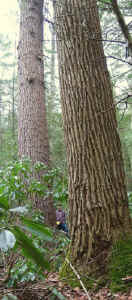
Base of Loner with big tuliptree nearby w/Jess at
base |
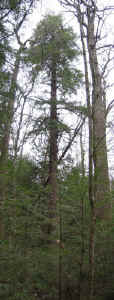
162' (not that tall) stitch w/Crown = Whole tree from east side |
During research for Tsuga Search scouting areas I located a
record in my
notes of a giant hemlock on eastern Winding Stairs Branch,
Cataloochee, NC,
GRSM from 1998. The record listed a very tall and large diameter
tree,
clearly justifying a search of the area to relocate it. The
first attempt
Jess and I made to relocate the tree was successful. We found
the tree just
below the gravel entrance road into Cataloochee Valley, but the
day was so
foggy we could not even get the laser to work. We
cross-triangulated the
enshrouded top and estimated the tree to be between 158 and 166
feet tall.
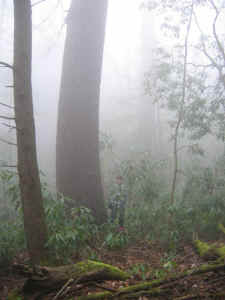
The foggy discovery day
We returned with laser and monocular in hand to document the
tree. Laser
shots estimated the tree to be over 160' tall and the monocular
suggested an
impressive volume of approximately 1223 cubic feet. The
topographical
location of this tree defied all we previously knew about where
the tall
trees grow. The lack of adjacent shelter, relatively high
elevation, and
lack of tall canopy competition do not ordinarily support a tree
of this
stature. Hence its pet name, "The Winding Stairs
Loner". It truly is an
imposing tree as it stands unchallenged.

Photo of Will by Bob Weber
As part of the Tsuga Search project we returned again to perform
a climb of
the tree and a vegetation survey surrounding the tree. The climb
would also
serve to assess the accuracy of the previous monocular
measurements. We were
graciously assisted by Bob Weber, a two-time ISA International
Tree Climbing
Champion and hemlock preservation enthusiast. He and I have
wanted to climb
together for many years and this was a great tree in which to
get further
acquainted.
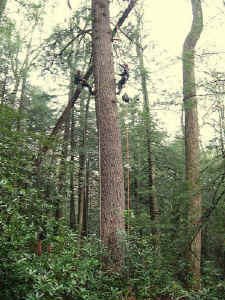
Will and Bob taking volume measurements (Jess Riddle shot) |
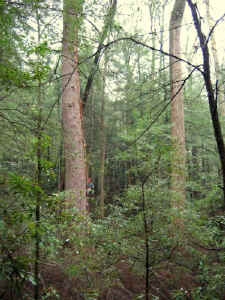
Bob Weber and tapes along the trunk |
We set a rope and headed up. The top turned out to be split into
four
reiterations, all of which were over 156 feet high. The tape
drop revealed
the height to be 158'10", less than the laser shot had
suggested. We were
hoping to confirm the only known hemlock both 15 feet in girth
AND 160'
tall. Alas, it was not to be.

Bob Weber at the base |
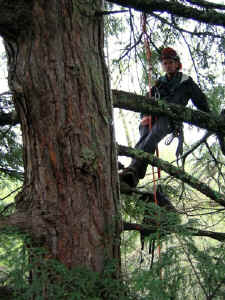
Bob Weber at the 100' point |
Bob and I measured the girths aloft while Jess diligently
sampled the
vegetation subplots and mapped canopy trees. The climb data
indicated the
volume was slightly less than the monocular measurements. Bob
Weber and I
measured the volume to 1180 cubic feet, 43 cubes (3.5%) less
than the
ground-based shots. Still, this was well within our goal of no
more than a
5% error. At this time it is the sixth largest climbed hemlock
in the
Smokies, but will not likely remain in the top ten largest trees
once the
Tsuga Search is complete. It is currently stationed as the 7th
largest
hemlock documented thus far, with one larger tree outside of the
Smokies.

View of tree from the south (Bob Weber photo)
This tree grows in one of the few remaining green groves of
hemlock
remaining in Cataloochee Valley. For this reason we have
recommended that
the National Park Service perform some aggressive soil
treatments to try to
preserve large sections of it. This same creek once contained
the tallest
("Tsali"; 169'10") and the largest ("Yonaguska";
1402 ft3) eastern hemlocks
in the Smokies, and at one time grew four hemlocks over 160'-
with several
just a few feet less. Many huge hemlocks grow along Winding
Stairs Branch
and this drainage may contain some of the finest hemlock forests
remaining
in salvageable condition in the NC portion of GRSM.
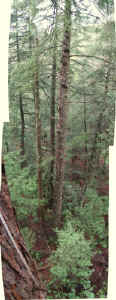
Stitch of adjacent tree and water below
Also of interest in this grove are three other trees, one of
which is a very
nice 75' tall American chestnut (tallest in the Smokies). The
two other
trees, both within the vegetation plots, are the tallest and
oldest rosebay
rhododendron currently known in the Smokies. The tall tree is
32' tall and
the oldest is 141 years at 4.5 feet (sampling height). Within
the Tsuga
Search, Jess and I are trying to sample rhododendron in all of
the plots
that it occurs. Little is known about the maximum age of this
species. We
have found several over 100 years old and I expect to break 150
years with a
few more samples.
Thanks go to the NPS for providing the means to chemically treat
the tree
last fall. We hope to preserve the grove around it once some
funding comes
through for the chemical. Every season lost is a potential win
for the
adelgid. (unattributed photos by Will Blozan)
Will Blozan
|